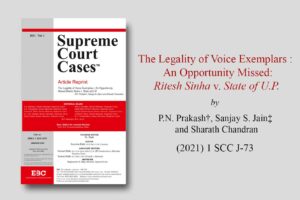The legality of orders passed by criminal courts directing the accused to furnish voice samples for the purposes of investigation had been hanging fire for nearly a decade. The controversy was finally set at rest by a recent three-Judge Bench of the Supreme Court in Ritesh Sinha v. State of U.P.1 Invoking its plenary powers under Article 142 of the Constitution the Court, by a process of judicial interpretation, conferred jurisdiction on Magistrates to pass such orders till explicit provisions were engrafted into the Code of Criminal Procedure, 1973 (CrPC)2. While the Supreme Court was right in its final conclusion, the Court’s invocation of Article 142 of the Constitution was not really necessary as this power was clearly available in the existing law i.e. Section 54-A CrPC.
I.
The question of whether an accused could be compelled to furnish a sample of his voice was considered by the Law Commission in its 87th Report on the Identification of Prisoners Act, 19203. The Commission noted that the voice prints were being commonly used in other jurisdictions to detect crime4. However, it opined that the law, as it stood then, did not authorise the use of force to obtain a voice sample5. The Commission also added that there “was no specific statutory provision in India which expressly gives power to a police officer or a court to require an accused person to furnish a specimen of his voice”.4 Accordingly, the Commission suggested a suitable amendment to Section 5 of the 1920 Act, so as to explicitly empower the courts to direct an accused to give a sample of his voice6.
Ritesh Sinha case1 arose out of a prosecution under Sections 417, 420, 468 read with Section 34 IPC. Ritesh Sinha and one Dhoom Singh were alleged to have hatched a scam to collect money from innocent persons promising them recruitment in the police department. Dhoom Singh was arrested and a mobile phone was seized from his custody. From the seizure, the police came into possession of a recorded conversation between Dhoom Singh and Ritesh Sinha touching upon the transaction in question. The prosecution moved the Chief Judicial Magistrate, Saharanpur for an order directing Ritesh Sinha to appear and furnish a sample of his voice for comparison with the recorded conversation. The Magistrate allowed the application, and Ritesh Sinha moved the Allahabad High Court to quash the order contending that he cannot be compelled to give a voice sample as it would violate his fundamental right under Article 20(3) of the Constitution. A learned Single Judge of the Allahabad High Court7 rejected the challenge. The matter travelled to the Supreme Court where Justice Ranjana Prakash Desai and Justice Aftab Alam, found8 themselves in disagreement with the source of power for a Magistrate to order the furnishing of a voice sample.
READ COMPLETE ARTICLE HERE
† Judge, Madras High Court.
†† Professor of Law and Principal, I.L.S Law College, Pune
††† Advocate, Madras High Court.
*The article has been published with kind permission of Eastern Book Company. Cite as (2021) 1 SCC J-73
1(2019) 8 SCC 1, para 27.
2Id, at para 27.
3 Law Commission of India, 87th Report on the Identification of Prisoners Act, 1920, (1980).
4Id, at p. 18.
5Id, at p. 8.
6Id, at p. 20.
7Subhash Chandra Gupta v. State of U.P., 2011 SCC OnLine All 1235.
8Ritesh Sinha v. State of U.P., (2013) 2 SCC 357.
101973 SCC OnLine US SC 23 : 35 L Ed 2d 67 : 410 US 1 (1973).
11Id, para 14.
122010 SCL 247.
13Id, para 35.
14Ritesh Sinha v. State of U.P., (2013) 2 SCC 357, para 40.
15Id, para 60.
16Id, para 97.
17Prakash v. State of Karnataka, (2014) 12 SCC 133.
19Surendra Dinda v. Emperor, 1945 SCC OnLine Cal 118 : AIR 1949 Cal 514.
20Daryao Singh v. State, 1951 SCC OnLine All 226 : AIR 1952 All 59.
211882 SCC OnLine All 7 : ILR (1883) 5 All 163.
22Id, ILR at p. 172.
25 This evidence was, however, found to be of little value since the precautions necessary to establish that the voice identification was reliable was not taken. Hence, the conviction based solely on the basis of voice identification was set aside.
26Ritesh Sinha v. State of U.P., (2013) 2 SCC 357, para 52.
27Id, para 53.
28Kirpal Singh v. State of Punjab, (1964) 3 SCR 992 : AIR 1965 SC 712.
30(2018) 18 SCC 695. It is, however, arguable that such an approach, in cases where victims are blind for instance, manifests an ableist model of disability. Where the victim is blind, it is possible that the recognition of the voice of the accused is the best and perhaps the only piece of evidence the victim can offer if he/she has not had the opportunity of touching the accused. If the principle laid down in Dola, (2018) 18 SCC 695 is applied mechanically, it would result in the evidence not getting its due weightage in the process of marshalling of evidence. It, is therefore, possible that a miscarriage of justice may arise. Hence, the previous acquaintance requirement in cases involving voice recognition ought not to operate as an absolute rule.
31Id, 705, para 23.
32 Code of Practice D to Police and Criminal Evidence Act, 1984 : Code of practice for the exercise by police of statutory powers to identify persons (most recent edition made pursuant to Police and Criminal Evidence Act, 1984 (Codes of Practice) (Revision of Codes C, D and H) Order 2017, SR & O 2017/103).
33R. v. Hersey, (1998) Crim LR 281. See also David C. Ormerod, “Sounds Familiar? Voice Identification Evidence”, 2001 Crim LR 595-622.
34Ritesh Sinha v. State of U.P., (2013) 2 SCC 357, para 49.
36Id, para 169.
37Id, para 16.
38Id, para 23.
39Id, para 27.
41Id, 651, para 39.

